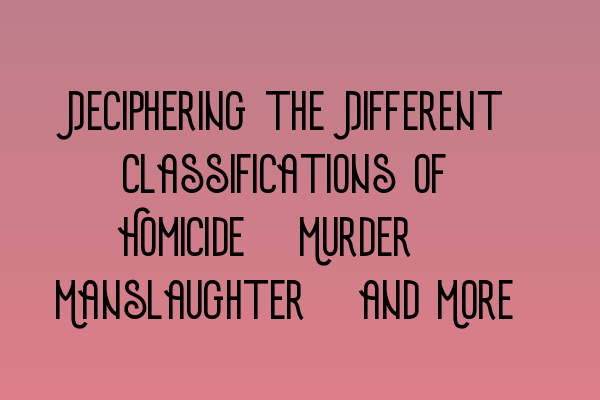Deciphering the Different Classifications of Homicide: Murder, Manslaughter, and More
The realm of criminal law often encompasses a wide range of offenses, and one area that sparks significant interest and debate is homicide. Homicide refers to the act of one person causing the death of another, but within this broad category, there are several different classifications that vary in their level of severity and intent.
Murder
Murder is the most serious classification of homicide, characterized by the deliberate and unlawful killing of another person with malice aforethought. This means that the perpetrator intended to cause the death of the victim or exhibited a reckless disregard for human life. The justice system treats murder as a heinous crime, and the consequences are often severe, ranging from lengthy prison sentences to life imprisonment or even the death penalty.
If you’re preparing for the SQE 1 exam, make sure to check out our SQE 1 Practice Exam Questions for comprehensive practice.
Manslaughter
Manslaughter is another classification of homicide, but it differs from murder in terms of intent and level of culpability. Manslaughter generally involves the unlawful killing of another person without the malice aforethought present in murder cases. There are two main types of manslaughter: voluntary and involuntary.
Voluntary manslaughter occurs when the offender kills another person in the heat of passion, often as a result of provocation or sudden rage. This classification recognizes that the offender’s actions were impulsive and not premeditated.
Involuntary manslaughter, on the other hand, typically involves unintentional killings that occur during the commission of another crime or due to the perpetrator’s reckless behavior. The lack of intent distinguishes it from murder and voluntary manslaughter.
For further practice, take a look at our SQE 1 Practice Mocks FLK1 FLK2.
Other Classifications of Homicide
Aside from murder and manslaughter, there are additional classifications of homicide that differentiate the circumstances and intent behind the crime.
- Infanticide: Infanticide refers to the killing of a child under 12 months old by their mother, usually as a result of postnatal depression or other mental health issues.
- Corporate Manslaughter: This classification applies to cases where a death occurs as a result of gross negligence or a serious failure to fulfill a duty of care on the part of a company or organization.
- Assisted Suicide: Assisted suicide involves intentionally aiding another person in ending their life due to their request, usually in cases of terminal illness or extreme suffering. This classification is often highly debated and subject to legal and ethical considerations.
If you’re interested in learning more about criminal law and preparing for the SQE 2 exam, check out our comprehensive SQE 2 Preparation Courses.
Conclusion
Homicide is a complex area of criminal law, with different classifications that depend on the intent, level of culpability, and circumstances surrounding the killing. Understanding these classifications is essential for legal professionals and aspiring solicitors alike.
For those preparing for the SQE 1 exam, our SQE 1 Preparation Courses can provide you with the necessary knowledge and skills to excel. Stay updated on the latest SRA SQE Exam Dates to plan your study and exam schedule effectively.
Remember, the legal field is constantly evolving, and staying informed is crucial to your success.
